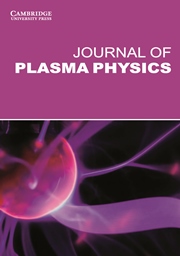No CrossRef data available.
Article contents
Experimental study on the formation and evolution of unconfined counter-helicity spheromaks merging using magnetized coaxial plasma gun
Published online by Cambridge University Press: 25 October 2024
Abstract
The formation and evolution of unconfined counter-helicity spheromaks merging have been experimentally investigated by using a magnetized coaxial plasma gun. By comparing the time-dependent photodiode signals and plasma radiation images of counter-helicity spheromaks merging and plasma jets merging, it is found that the field-reversed configuration (FRC) plasma formed by counter-helicity spheromaks merging has a distinct contour and a long maintenance time. For plasma jets merging, the resulting plasma has no discernible contours and a shorter lifetime. In addition, it is inferred from these data that stagnation heating and magnetic reconnection events occur during the counter-helicity spheromaks merging, causing a rapid rise in plasma pressure at the merging midplane and sharp kinks in the field lines near the merger region. By changing different operating parameters and observing the impact on the merger characteristics, it is suggested that the qualitative dynamics of the FRC plasma depends on the balance between the plasma pressure and the magnetic pressure. The high discharge voltage breaks the equilibrium in the merged body, while the large gas-puffed mass just weakens the compression effect of the merged body. These results give us an intuitive understanding of the counter-helicity spheromak merger process and its dependence on discharge parameters, and also provide a distinct perspective for the optimal design of FRC.
- Type
- Research Article
- Information
- Copyright
- Copyright © The Author(s), 2024. Published by Cambridge University Press



